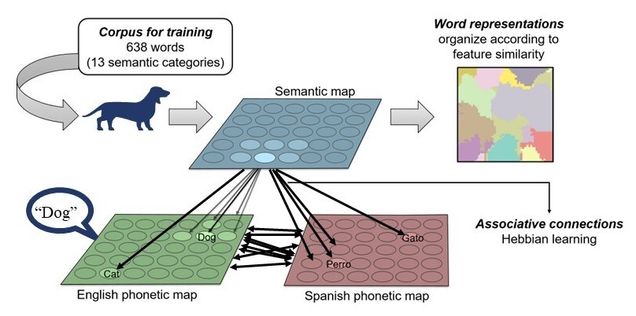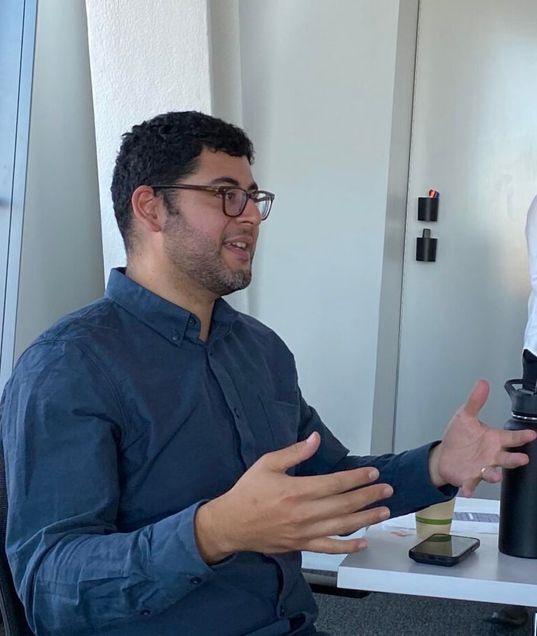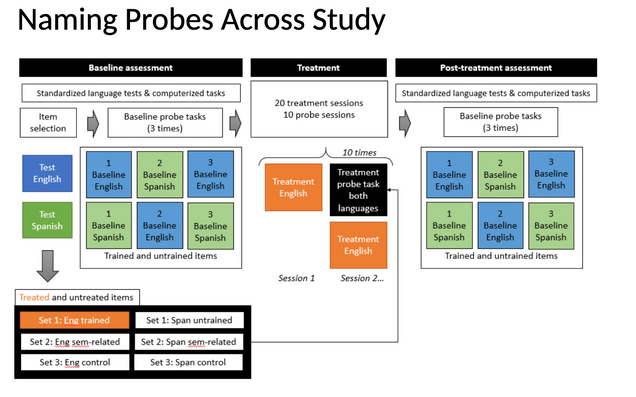Advancing Bilingual Aphasia Treatment With Boston University Researchers’ PROCoM Projects
Introduction
Predicting Rehabilitation Outcomes in Bilingual Aphasia using Computation Modeling (PROCoM) is a concept pioneered by Boston University’s Center for Brain Recovery, led by Swathi Kiran and in development by researchers Erin Carpenter, Manuel Marte, Marissa Russel, and Michael Scimeca and researcher collaborators at UT-Austin Risto Miikkulainen and Uli Grasemann. The project leverages computational modeling and machine learning to predict and improve therapy outcomes for bilingual individuals with aphasia. Through interviews with each of these researchers, we will delve into the key aspects of PROCoM and the valuable insights gained from their innovative projects.

Annotated architecture of the BiLex model. The model consists of three computational Self Organizing Maps (SOMs) –one for the semantic representations of words shared across languages, and two for the phonetic representations of words in each language.
Overview of PROCoM with Erin Carpenter

How would you explain what PROCoM is?
“PROCoM is a Randomized Control Trial (RCT) that uses computational modeling to predict how a bilingual person with aphasia will respond to therapy provided in both languages based on their baseline assessment scores, bilingual language experience, and other demographic information. Based on this information the model ‘assigns’ which language is most optimal for treatment to promote direct treatment gains and cross-language generalization. Each patient was then randomly assigned to a treatment language (either model assigned or model opposite) and received 40 hours of therapy. We then compared how the patients actually improved in therapy to what the model predicted for that given language.”
“The primary goal of the PROCoM is to understand the factors that promote response to treatment and cross-language generalization in bilingual aphasia. By utilizing computational modeling, BU researchers aim to enhance our understanding of language rehabilitation efficacy and its impact on brain recovery in bilingual individuals with aphasia.”
Interview with Manuel Marte

Can you tell us about your recent research – Machine learning predictions of language recovery in bilingual aphasia: Aligning model insights with clinical evidence – and how it integrates PROCoM?
“This project aimed to determine how various factors could predict language therapy outcomes in bilingual persons with aphasia in both their treated and untreated languages. It examined a combination of demographic data, bilingual language experience, aphasia severity, language assessments, cognitive assessments, and factors relating to treatment. Using a variety of machine learning approaches, the study analyzed how these variables influenced treatment responsiveness in 48 bilingual persons with aphasia. The top-performing models revealed that the most accurate predictions for the treated language outcome were influenced primarily by demographic information, such as age and education, and aphasia severity in the treated language, whereas for the untreated language outcome, aphasia severity in the untreated language and bilingual language experience in both languages were the key factors. Importantly, the machine learning approaches outperformed traditional statistical approaches, showing their effectiveness in capturing the complexity of the various factors influencing aphasia recovery in bilingual individuals. This research provides insights into optimizing language therapy for bilingual persons with aphasia, delivering actionable insights for clinicians to tailor more effective, individualized treatment plans.”
As described by Marte, the application of machine learning in predicting therapy outcomes for bilingual aphasia contributes to a deeper understanding of brain recovery. The research identifies essential factors that play a crucial role in language rehabilitation, paving the way for more targeted and effective treatments.
Interview with Michael Scimeca

Michael Scimeca’s contributions to the PROCoM project include two key investigations aimed at predicting treatment outcomes in bilingual aphasia.
Can you tell us about the two projects you have recently worked on involving PROCoM?
Examining multilevel factors for predicting treatment outcomes in bilingual aphasia
“The goal of this project was to examine three distinct levels of factors to determine whether they could be used to predict treatment outcomes in the treated language and untreated language for 34 PROCoM participants. We investigated: 1) intervention-level factors including: a) time in treatment and treatment language; 2) participant-level factors including age and baseline naming severity; and 3) item-level factors including lexical frequency, phonological length, and phonological neighborhood density for participants’ treatment stimuli. Participants showed more improvement in the treated and untreated language if they had milder naming severity at baseline and completed more treatment sessions. In the treated language specifically, treatment in their first acquired language (or L1) predicted greater treatment response. Finally, participants who were trained on words with shorter phonological length but greater (denser) phonological neighborhoods improved more in the treated language. These results suggest that multiple levels of treatment design may influence outcomes for Spanish-English bilinguals with aphasia. During treatment planning and implementation, clinicians and researchers alike should evaluate a variety of parameters to ensure their treatments are poised to maximize language recovery.”

The results from this project were published in August 2023:
Scimeca M, Peñaloza C, Kiran S. Multilevel factors predict treatment response following semantic feature-based intervention in bilingual aphasia. Bilingualism: Language and Cognition. 2023:1-17. doi:10.1017/S1366728923000391

Investigating the evolution of word retrieval errors during treatment for bilinguals with aphasia
“The goal of this project was to analyze word retrieval errors and subsequent treatment outcomes for a group of 48 Spanish-English bilinguals with aphasia to determine if longitudinal error patterns could capture language recovery. Results revealed naming improvement for trained items in the treated language and translations of trained items in the untreated language. Specific types of word errors at pre-treatment were associated with overall improvement in both languages; furthermore, patterns of responses changed over time as a function of lexical-semantic treatment. These results demonstrate error analyses may characterize bilingual treatment outcomes and provide new evidence for mechanisms of impaired word retrieval.”
Both of Scimeca’s projects contribute to a comprehensive understanding of multilevel factors influencing treatment outcomes in bilingual aphasia. The findings emphasize the importance of considering various parameters during treatment planning to maximize language recovery.
Conclusion
As these interviews describe, Boston University’s PROCoM based research is at the forefront of advancing research in bilingual aphasia treatment. By combining computational modeling, machine learning, and detailed analyses of treatment outcomes, the Center for Brain Recovery’s work is shedding light on the intricate factors influencing language recovery. These insights have the potential to transform therapeutic approaches for bilingual individuals with aphasia, ultimately improving their quality of life.